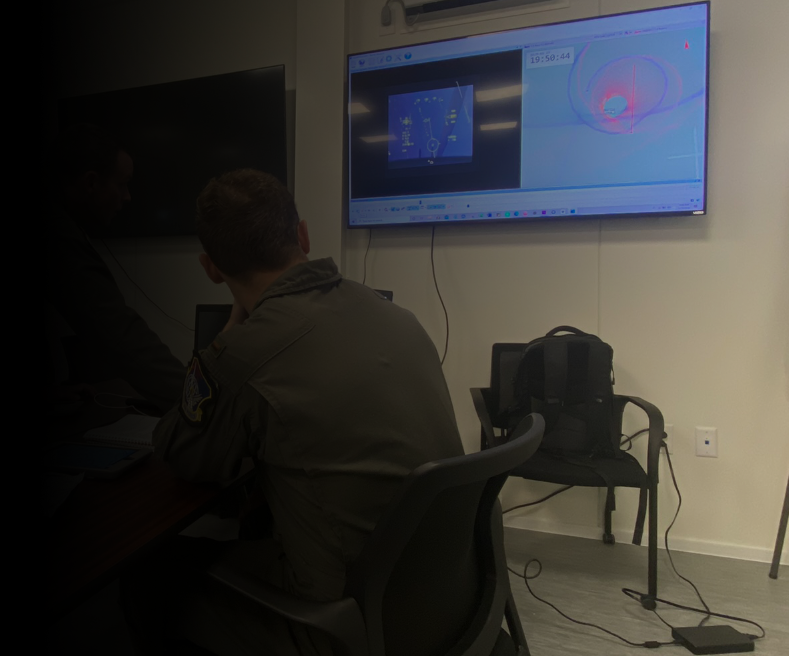Formation Maneuver Success
Precision Intervention for Rapid Skill Development

Challenge
A student was struggling with a critical formation maneuver known as wing work. Despite repeated attempts, the student remained unstable while leading the maneuver. This persistent difficulty presented several challenges:
-
Performance Plateau: The student had reached a frustrating plateau where additional practice flights were not yielding improvement, potentially affecting their progression through the training program.
-
Resource Inefficiency: Continued in-flight attempts were consuming valuable aircraft time and resources without resolving the fundamental issue.
-
Confidence Erosion: Repeated unsuccessful attempts were beginning to affect the student's confidence, which could potentially impact performance in other areas of training.
-
Unclear Root Cause: Initial debriefs had not successfully identified why the student was struggling with this particular maneuver despite competence in other areas.
A deeper analysis during debriefs revealed the root cause: the student lacked effective visual references to guide their inputs during the maneuver. This insight was critical, as it shifted the focus from general practice to addressing a specific perceptual gap in the student's technique.
Solution
We identified that the issue was primarily cross-check-based and used a simulator session to address it. Our approach was highly targeted and efficient:
-
Focused Simulator Intervention: Within just 10 minutes, the student was guided through the maneuver in a simulator environment where they could concentrate exclusively on developing the necessary visual references without the pressure of actual flight.
-
Visual Reference Development: We specifically trained the student to identify and utilize precise visual cues that would guide their control inputs during the maneuver, creating a reliable framework for consistent execution.
-
Control Input Calibration: The student was coached on the appropriate magnitude and timing of control inputs based on the visual references, helping them develop a more intuitive feel for the maneuver.
-
Immediate Feedback Loop: The simulator environment allowed for real-time feedback and immediate repetition, accelerating the learning process and reinforcing correct techniques.
This approach exemplified our philosophy of precision intervention—identifying the exact point of difficulty and applying a targeted solution rather than prescribing generic additional practice. By focusing specifically on the visual reference aspect of the maneuver, we were able to address the root cause directly and efficiently.

Attacking Root Cause
Visual Reference Training
Developed precise visual references through targeted simulator sessions.
Rapid Intervention
Implemented a focused 10-minute simulator session to address specific challenges.
Performance Analysis
Conducted detailed debriefs to identify and correct specific performance issues.

Detailed Results
Dramatic Performance Improvement
The student's performance improved dramatically, progressing from a U (Unsatisfactory) grade to an Excellent grade in subsequent sessions. This remarkable transformation occurred after just one targeted simulator intervention, demonstrating the power of addressing the specific root cause.
Enhanced Confidence and Understanding
The simulator session not only resolved the immediate issue but also solidified the student's confidence and understanding of formation leading. By providing clear visual references, we transformed uncertainty into mastery, with positive effects extending beyond the specific maneuver.
Validated Methodology
This quick, targeted intervention demonstrated the effectiveness of pairing root cause analysis with tailored simulator-based training. The approach proved far more efficient than continued in-flight practice without addressing the underlying perceptual gap.
Resource Optimization
By resolving the issue in a 10-minute simulator session rather than through additional flight time, we achieved significant resource savings while delivering superior results. This efficiency is particularly valuable in training environments where aircraft availability and flight hours are limited resources.
Transferable Skills Development
The visual reference techniques learned during this intervention provided the student with a framework that enhanced their performance in other formation maneuvers as well, creating a multiplier effect from the single intervention.
Instructor Development
This case provided a valuable template for instructors to identify and address similar issues with other students, enhancing the overall effectiveness of the training program.
Summary
This case study exemplifies our approach to training optimization: identifying precise root causes, applying targeted interventions, and leveraging simulation technology to accelerate skill development. By focusing on the specific perceptual gap rather than prescribing generic additional practice, we were able to transform a struggling student into an excellent performer in minimal time, demonstrating the power of precision in training methodology.

Rapid Improvement
Dramatic performance enhancement in a single session.

Confidence Building
Strengthened student's understanding and self-assurance.
Skill Mastery
Achieved excellent performance in formation leading.

Lasting Results
Established foundation for continued success in formation flying.
